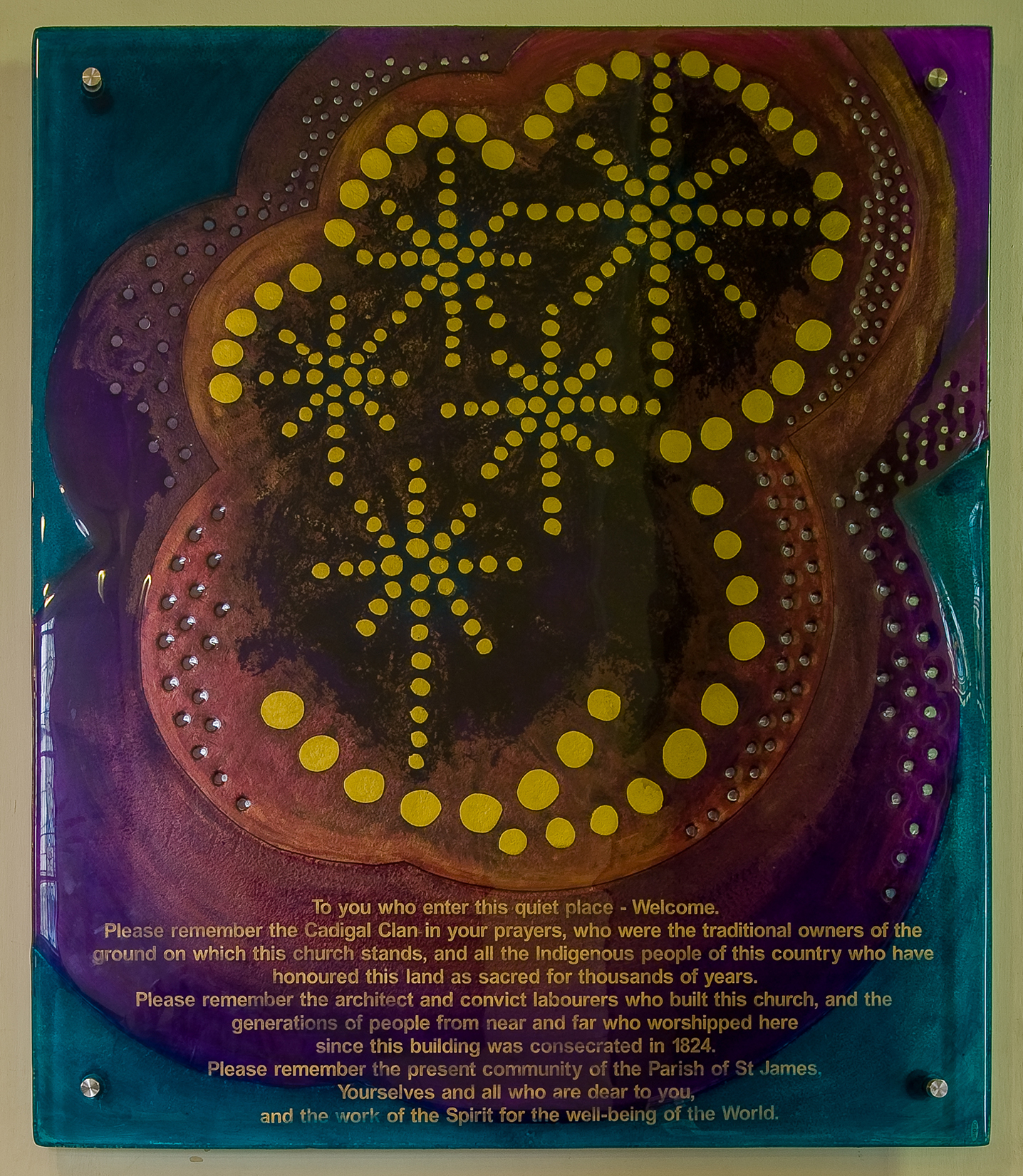Reconciliation Plaque

To you who enter this quiet place – Welcome
Please remember the Cadigal clan in your prayers, who were the traditional owners of the ground on which this church stands, and all theIndigenous people of this country who have honoured this land as sacred for thousands of years.
Please remember the architect and convict labourers who built this church and the generations of people from near and far who have worshipped here since this building was consecrated in 1824.
Please remember the present community of the Parish of St James,
Yourselves and all who are dear to you,
and the work of the Spirit for the wellbeing of the World.
The Reconciliation Plaque
On the arch separating the baptistery from the nave of the church is the Reconciliation Plaque. This striking piece of glass art is a contribution by the parish to the ongoing work of reconciliation in Australia. Executed by the indigenous artist Nikki McCarthy, it is made of architectural slump glass. Its design evokes the Southern Cross and uses traditional dot design. Its materials, however, are modern and forge a link between the ancient world of aboriginal dreaming and the modern world of technology. The text on the plaque asks visitors to remember the Cadigal people, the traditional owners of the land on which the church stands, those who built the church and those who have worshipped here.
The Artist
The artist, Nikki McCarthy, is a Wiradjari woman from the central west of New South Wales. A masters graduate of the College of Fine Arts at the University of New South Wales, she has been artist-in-residence at the Art Gallery of New South Wales. She specialises in public art and has had a number of major commissions and exhibitions.
The Dedication
The plaque was dedicated on 27 May 2001 in a service that used the following words:
Today marks a step in the movement towards reconciliation and unity in the Parish Church of St James. The geographical parish of St James contains the place where the British occupation of Australia was first proclaimed and where sustained contact between the occupiers and Australia’s indigenous inhabitants began. The parish also contains the sites of the nation’s first parliamentary institution and first law courts. This church, the oldest ecclesiastical building in Sydney, stands as a symbol of the establishment of Christianity and Anglicanism in this country. Built by the forced labour of convicts transported from their homeland on land taken from its indigenous owners, it represents the ambiguity of our history, with its successes and failures, its pride and shame.
In our journey of understanding and reconciliation we have begun to understand our own building, the indigenous culture of the local area and the need for continuing steps towards a new life together. This morning we dedicate a visual symbol of that journey. This symbol will, we hope, stand both as a mark of change and a continuing invitation to join the journey.
Reconciliation stands at the heart of the Christian gospel. In a fractured world God calls us to repentance and to new life in Christ. Being reconciled with God we are enjoined to be reconciled with each other.
Special mention was made of the past with these words:
The walls of churches are hung with remembrances of death. This place records a small and particular part of the conflicts that followed the European occupation of Australia. Those conflicts took the lives of about 20,000 indigenous people and about 2,000 Europeans. We pause to remember those known and unknown victims of our past conflicts.
Grant, O God, that your holy and life-giving Spirit may so move every human heart and especially the hearts of the people of this land, that barriers which divide us may crumble, suspicions disappear and hatreds cease; that our divisions being healed, we may live in justice and peace; through Jesus Christ our Lord. Amen.
The plaque was dedicated with these words:
This plaque, designed and painted by Nikki McCarthy, crafted by Ozone and installed by Gary Veitnch, invites those who enter this place to acknowledge the Cadigal clan and to pray for those who seek wholeness and healing in this place.
We thank you, Creator God, for the gift of artistic expression and for the skills of workers. We thank you for those who cared for the land on which this church stands, who built this church and who have worshipped in it. We dedicate X this plaque to you as a symbol of our heritage and of our common search for life together. May it stimulate, inspire and strengthen us and all who will see it in the years to come. Amen.
The future work of reconciliation was addressed in these words:
We have recognised the pain of our past, we have dedicated ourselves to our present task. We now recognise that the work of unity and love is never finished. Occasions of conflict and division will continue to present themselves to us. In a nation of many cultures we ask for God’s help in forging our future in peace and mutual respect.
Heavenly Father, who has filled the world with beauty: open our eyes to see your gracious hand in all your works; that, rejoicing in your whole creation, we may learn to serve you with gladness; for the sake of him through whom all things were made, your Son Jesus Christ our Lord. Amen.
